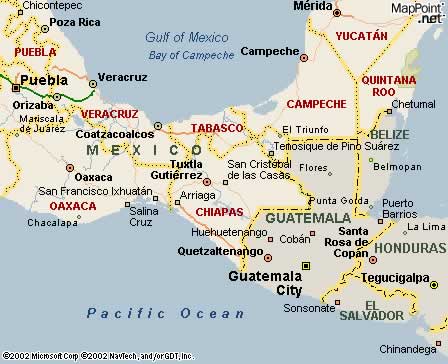Dispatch: Civil Strife in Chiapas, Mexico
 Hey all, I’ve been focusing some attention here on the situation in Oaxaca, a past and still presently popular place with adventure travelers. Anyone that has spent much time in Mexico or Latin America, will also be familiar with similiar incidents in the Mexican state of Chiapas. Well, things are once again heating up there, so I send this dispatch from a correspondent on the ground there. This was forwarded to me from the good people at the Prometheus Radio Project. You can click to enlarge the map on the right:
Hey all, I’ve been focusing some attention here on the situation in Oaxaca, a past and still presently popular place with adventure travelers. Anyone that has spent much time in Mexico or Latin America, will also be familiar with similiar incidents in the Mexican state of Chiapas. Well, things are once again heating up there, so I send this dispatch from a correspondent on the ground there. This was forwarded to me from the good people at the Prometheus Radio Project. You can click to enlarge the map on the right:
San Cristobal de las Casas – Tension is mounting in this community under siege, harassed by the constant sight and sound of low flying government planes and helicopters, and news of troops and paramilitaries gathering at the outskirts of town. The word is that the Mexican Army will invade any day now to forcibly remove the entire community. While much attention has been focused on the struggle between poor communities and the state authorities in Oaxaca, the Mexican government continues to wage a low-intensity war against indigenous communities in the very fertile and resource-rich state of Chiapas. This particular battle is taking place in the village of Chol de Tumbala , an indigenous community in Northern Chiapas. The village is part of the network of autonomous Zapatista municipalities in the state, this one named El Trabajo.
The Chols are about to face eviction, for the second time, from the ancestral lands they have struggled over the past decade to get a legal claim to. The lands, which once were covered with dense jungle, and inhabited by the Chols, have over the past decades been deforested by vast cattle ranches, and their valuable timber sold on world markets.
Background:Since 1994, when the Zapatista Army of National Liberation (EZLN) launched its campaign to fight for the rights of the indigenous peoples of Chiapas, the Mexican government has deployed an array of tactics against the Zapatistas and their supporters- from attempts to discredit the movement in the press, to torture, rape, imprisonment and outright murder. Although the people of Chiapas are poor, the state is a rich one, with valuable sources of water, timber and cattle ranching. These lucrative industries however are dominated by large landholders, latifundas. Together with the state and federal governments, and their private armies of paramilitaries, these landowners have waged war against the indigenous peoples of the state. One of the most horrific examples was the massacre of 45 people attending a church service in Acteal in 1997. However the Acteal massacre was only one in a long history of forced displacement, assassination and rape, in which hundreds have died and hundreds more have been made landless.
The Chols’ battle to (re)establish a community on their ancestral lands in Palenque municipality, began in 1988, when they submitted a formal petition to the federal secretary of Agrarian Reform. Between the time the request was published in 1990 and 1995, the federal and local authorities issued numerous contradictory decisions, finally ruling against the Chols in January of 1995. The land in question consists of 532 hectares.
Once it became clear that legal avenues were closed to them, that the government would not act to protect their right to land and a living, the community decided to take a bold stand and in their words liberate the land. In September 1999, 30 families, members of different communities in the area, supporters of the EZLN, reoccupied these ancestral lands and set to work building a future for their families and future generations. They named the village Chol de Tumbala.
On August 3, 2006, life in Chol de Tumbala was violently disrupted. At 10.30 in the morning, villagers were presented with an eviction notice from the Federal Judge of Playas de Catanza, who told them they had 10 minutes to vacate the land. At 11.30, vans carrying more than 260 people- among them municipal police, public security forces and people dressed as civilians, invaded the village and set about destroying it. They burned and bulldozed the houses, and destroyed clothes, kitchen utensils, dishes and fruit trees, before taking all the villagers? property, including the husked maize which is the staple of their diet. Three villagers were imprisoned, forced to sign documents saying they had left the land voluntarily, and then later released. At this stage the government produced a list of prior owners of the land.
Early this month, the villagers returned to their homes to set about rebuilding them. While the world’s attention is focused on Oaxaca, they face the imminent threat of another, potentially more violent, eviction from their homes and lands.
var MyShoutItURL = “https://www.shoutwire.com/comments/33684”;